Ready or Not, Winter Storms Are on the Way
Howling blizzards, ice storms, power outages. Emergency services are on high alert, but when disaster strikes, the first line of defence is you.
“Don’t worry. Be happy!”
Words to live by – when heard in reggae rhythm while sitting in a deck chair on a white beach, sipping a mai tai.
Back home, however, with winter storms on the horizon, mindless happiness can be a bad idea. Even though we know we should be stocking the pantry and laying in the firewood like the responsible ant of Aesop’s fable, many of us are more like the happy-go-lucky grasshopper. We choose to ignore, forget, procrastinate or simply assume something unhappy – catastrophically unhappy – couldn’t happen to us or our community.
But with each passing year, the changing climate reinforces the risks of that carefree attitude. We are not immune here in these hills. Environment Canada reports that severe weather alerts (extreme winter or summer weather, or dense fog) in our region increased nearly every year from 2014 through 2018. In 2014, 39 alerts were recorded. By 2018, that figure had increased to 71. Projections for decades to come are for significant increases in the number of days below –15C and above 30C, as well as for a far greater number of “extreme precipitation events.”
Cause for worry can extend beyond weather and “acts of God.” There are hazards of our own making – homes built too close to flood plains or drought-dry woodlands, or our near-total reliance on electronic technology for daily business and financial transactions that leaves us more vulnerable in the event of a blackout or cyberattack.
But those things are easy to ignore on a fine summer morning. Imagine a sunny slice of sky viewed from the spacious Orangeville office of Sonya Pritchard, chief administrative officer of Dufferin County. The view is cloudless, blue and bright. Then blink – suddenly that clear sky is marred by a violent blizzard or the malevolent funnel of a tornado. Or let your imagination leap further, to human-made disaster – a tower of flame from a crashed airplane or a toxic plume of gas above an overturned chemical tanker.
Though some of these scenarios are less likely than others, any of one of them could happen. And if it did, the phone would ring, the computer monitors on Pritchard’s well-organized desk would light up, and the Dufferin County Emergency Response Plan would be launched.
On those computer screens, coloured blocks, charts and lists display the contacts and roles of a broad community of emergency staff and physical resources that can be mobilized. Rapidly. It is a template for countywide – and beyond – management of any and all emergencies, large and small, that can affect the people, properties, businesses and livestock of Dufferin County. Unfolding events are even ranked: incident, emergency (a multi-incident event), disaster (not since the Grand Valley tornado in 1985) and catastrophe (thankfully, never yet).
The screens are “a communication tool for the Command Centre,” says Pritchard, “but ‘command’ is a funny word. We record, we co-ordinate the flow of information, but we’re off to the side, overseeing. We don’t tell the emergency services people what to do.”
Here’s how the plan works. Something bad happens, perhaps a fire, an explosion, a flood or a blizzard. Local responders assess and begin dealing with the situation. Depending on the nature of the problem, an onsite incident commander may be named. In the case of a fire, for example, the commander would be the local fire chief, or if flooding destroys a gas line, a joint command would be established.
As the problem grows or is assessed to be greater than local resources can handle, escalating levels of the emergency response plan are involved. The full county plan doesn’t come into effect “unless it has to,” says Pritchard. “Various components of the emergency plan are activated depending on the situation.”
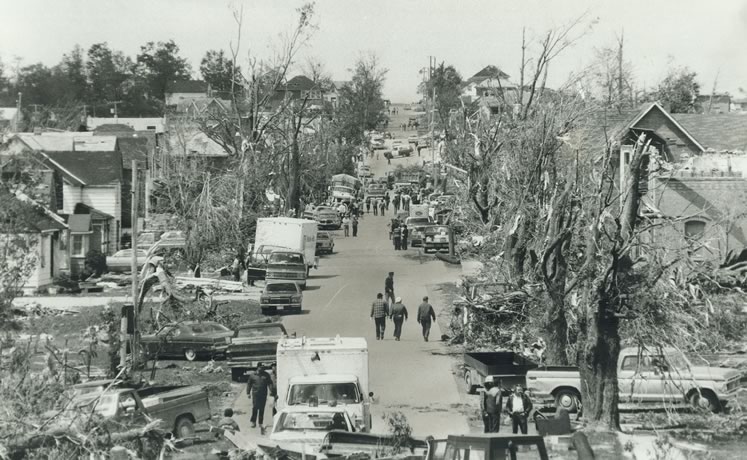
The scene along Amaranth Street in Grand Valley looked post-apocalyptic in the aftermath of a devastating tornado on May 31, 1985. David Cooper/Toronto Star via Getty Images.
The earliest version of the plan was put in place after a series of tornadoes ripped through these hills on May 31, 1985. The deadliest of the bunch levelled parts of Grand Valley and Mono before continuing its destructive path eastward. Two people were killed in Grand Valley and dozens of homes, barns and businesses were destroyed. Then along came the 9-11 attacks, and emergency planning ramped up significantly.
Across Ontario, provincial law requires municipalities to have an emergency management program in place. Like emergency response plans for Peel Region, Caledon and Wellington County, the Dufferin plan is available both online and as a printed document. Detailed and laden with acronyms – AAR, CEMC, PEOC and PNERP (Provincial Nuclear Emergency Response Plan) – the document includes more than nearly any resident needs to know, other than that it is in place, practised and proven – and that it delineates lines of authority and responsibilities.
Under the IMS (Incident Management System), a command section under an elected municipal official presides over four fields: planning, operations, logistics and finance, each with a section chief and subordinate leads who report to the chief and co-ordinate staff and volunteers as they carry out specified duties.
In operations, the public works lead ensures, among many other things, “that barricades and delineators are delivered to the emergency site to establish traffic control points and emergency perimeters as required.” Under finance, the human resources lead “co-ordinates offers of, and appeals for, volunteers.” The pre- and post-emergency functions of the business continuity lead are also detailed. Nearly all these people do this work, or are trained and prepared to do it, in addition to their day jobs as municipal employees.
The most important acronym in the handbook is HIRA (Hazards Identification and Risk Assessment). This detailed, well-thought-out list of Dufferin’s specific vulnerabilities lists potential effects on people, property, the environment and critical infrastructure, as well as psycho-social effects, such as evacuations and mass panic.
The probability of all hazards – natural (such as a tornado or ice storm), technological, (explosion, dam break) and human-caused (terrorism, civil disorder) – are assessed as high, medium or low, both right now and in the future, as circumstances change.
Knowing what might happen and how severe the effects are likely to be is considered as important as knowing how to deal with a particular emergency and how the situation might be mitigated or prevented in the future. And no, a “zombie apocalypse” has never been considered or assessed.
Pritchard leads a team that is impressively prepared, but she shies away from describing herself as a hero. For her, “hero” is a word better applied to those who implement the plan on the ground, often in the face of extraordinary risk and adversity. Pritchard’s role is administrative, she says. “I help make sure that other people make the trains run on time.”
Steve Murphy is one of those who keep the trains running. Dufferin County’s full-time emergency management co-ordinator for the past decade, Murphy is passionate, articulate and committed. Spend 10 minutes talking to him about his work and you will sleep more soundly at night. He labels himself simply “an adviser.”
He may advise, but given a chance – a community information meeting or an invitation to a neighbourhood gathering over coffee – he is a preparedness proselytizer par excellence. “This is my life,” he says. “The best and most effective way to manage an emergency is at the lowest possible level. Emergency preparation is only as good as the local corner store. It is only as good as you.
“If we have an incident, there is a chance the things you typically rely on – hospital, police, fire – are going to be overwhelmed, and it could be two or three days before we can get to everyone concerned. We need the public to know that if an incident occurs, start by taking care of yourself. We have a 72-hour guideline – have emergency supplies, have an emergency plan. You are the only one you can count on 100 per cent of the time to take care of you.”
Needless to say, Murphy practises what he preaches. He has a full kit of emergency stores in his home, car and office.
A 2018 survey showed only about 20 per cent of the citizens he serves in Dufferin County consider themselves prepared for 72 hours of self-sufficiency. For municipal employees, however, the figure is closer to 50 per cent, attributable to regular presentations, courses and lunch-and-learn information sessions.
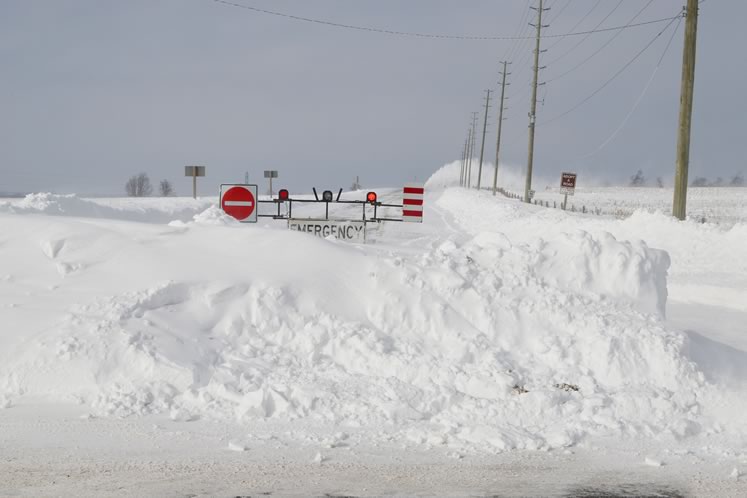
Emergency road closures are a common winter occurrence on many of Dufferin County’s windswept roads. A blizzard in 2014 left many motorists stranded and in need of rescue. Photo by Steve Murphy.
The most significant emergency in Dufferin County’s recent history was probably the blizzard of January 2014. It was a Friday night, ski season. People were heading north. The snow was coming down heavily – and it didn’t cease for a day and a half. County Road 124 north out of Shelburne was closed, as were Highway 10 north and Highway 89 to the east and west. Motorists became stranded in opaque, cold darkness.
“It was just another evening,” Murphy recalls. “It started with a phone call from the Mulmur-Melancthon fire chief saying people were stranded and needed shelter. He had a handful of them put up at the fire hall. Within a couple of hours, the Red Cross was deployed, our own staff were deployed and an EOC (Emergency Operations Centre) started to co-ordinate. Countywide, over four locations (mainly the Centre Dufferin Recreation Complex in Shelburne), the system sheltered 500 people in under four hours.
“By two or three in the morning, we knew we had to feed those people in a few hours. Snowstorm. No restaurants. One of our managers had a spouse who worked in a grocery store in Shelburne. She and an OPP officer opened the store, got the food needed and left an IOU for the manager. With our snowplows and a big truck, we got food out to the people. They had breakfast in the morning.”
The role of the EOC is to get all the information, compile it into a useful tool and put it out to the local decision makers and those on site. Logs were kept of allowable hours and overtime for plow drivers and other emergency staff. MOUs (memoranda of understanding) were activated to initiate help from the snow-clearing fleets of surrounding counties that had not been as badly hit.
“Documentation is really important,” notes Pritchard. “After an incident we assess all the impacts, including financial, and try our best to cover those if they go beyond municipal resources.” Emergency relief funding can be sought from the province.
The rescue of the snowbound and stranded around Shelburne was exacerbated when people were either unaware of the warnings on radio, television and social media, or simply didn’t heed them and ignored closed-road barriers. This can lead to life-threatening situations, warns Shelburne police chief Kent Moore.
“The problem is some people don’t listen,” says Moore. “They find ways around the road closures, or they take back roads and get trapped. Any time you can’t see two feet in front of you is a dangerous situation. You are at risk. You need food, water. Are you warmly dressed? 911 calls come in and officers are dispatched behind snowplows to rescue the stranded.”
Some motorists find themselves not only rescued and sheltered, but ticketed. The charge for driving on a closed highway carries a $110 fine and three demerit points. “Which unfortunately is not uncommon,” says Moore. “[Drivers who ignore road closures] put a lot of people at risk – fire, ambulance, police who have to attend. It’s a justifiable charge.”
Industrial and construction electrician John Guttridge and his wife, Jean, live in “paradise.” They also live within 100 feet of the Nottawasaga River in Hockley Valley. “It certainly makes life interesting,” Guttridge laughs. The Guttridges have experienced four floods in the six years they’ve lived there. The one in June 2017 was the worst. Guttridge tied his stepdaughter’s car to a tree. It sank.
“I can’t outsmart the river,” he says, “but I can find ways to live with it.” He recalls meeting Murphy at an area information session on flood preparedness. “He was the voice of Dufferin County saying, ‘You live on a flood plain. You are going to have to take care of yourself – sump pumps, food and emergency supplies, an evacuation plan. You can’t expect the government to look after you.’ When he stood there and said that, I think if we’d had pitchforks, we’d have rushed the stage! But cooler heads prevailed. He’s right. You can’t expect it. Be prepared.”
Among Guttridge’s inventive preparations is a small ultrasonic liquid level sensor (not something that can be picked up at Home Depot – he encountered it while working in a sewage plant in Toronto). The sensor is suspended over the river and connected to a traffic light-like warning system attached to the family garage. Green means good. Chill. Amber indicates a two-foot rise. Start watching very carefully. Red means move the vehicles and start making calls to warn a mutually supportive network of neighbours – and Steve Murphy.
“The Dufferin County Emergency Plan will act in floods or any emergency situation however it can,” says Murphy, “but lives are the priority. We look at property, we also look at the environment, but they don’t trump human life. We will risk almost everything to save people, but we cannot risk lives to save property.
“If there are floods, one of the biggest requests is socks. People are out there fighting floods. Feet are getting wet. The call comes. ‘We need 200 pairs of wool socks.’ We have a process. Our logistics section is sourcing them. Treasury arranges for payment. A supplier on our resource list is contacted. They are delivered.”
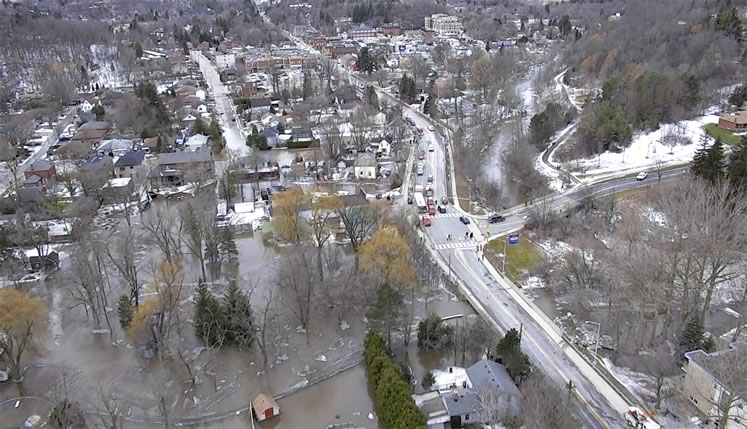
Caledon activated its Community Emergency Response Plan when the Humber River overflowed its banks in March this year, flooding nearly 120 homes. Courtesy Brampton Fire and Emergency Services.
It is much the same in neighbouring Caledon. In March this year, the Humber River near Bolton jammed with ice and overflowed its banks. The flooding, the first since flood protection infrastructure was put in place in the early 1980s, affected nearly 120 homes and about 400 people.
Caledon’s Community Emergency Response Plan was activated. Evacuations, “advising,” but not compelling, residents to leave an area officially deemed unsafe were phased in. Those most severely affected left first, immediately, if the danger was considered imminent. Elsewhere, firefighters went door to door conducting wellness checks, assessing risks and effects, and encouraging others to leave as a precaution. Roads and bridges were closed.
Evacuees who hadn’t taken refuge in hotels or on the sofas of friends or family were sheltered at the Caledon Centre for Recreation and Wellness. On the scene were OPP, Hydro One, Enbridge Gas, and fire and emergency services personnel from the Bolton, Caledon East and Palgrave stations, as well as the Toronto and Region Conservation Authority, Peel Paramedics and the Red Cross. Staff from the town of Caledon, as well as Peel Region’s emergency management, human services and communications teams were also activated. The Red Cross established a registry of displaced persons and a reunification hotline to aid communications for the mini-diaspora that lasted, at most, 48 hours.
This response was similar to the one that had taken place earlier in the year, when an early morning explosion in Caledon Village levelled one home, significantly damaged about five others, and affected some 15 more. The incident took one life and did an estimated $3.1 million in damage. About 100 area residents were evacuated while the cause – a gas leak – was thoroughly investigated and a return declared safe.
Those not covered by insurance in emergencies like these can apply to the Disaster Recovery Assistance for Ontarians program, activated by the province in response to specific incidents. Perishables lost were dealt with through a special Peel Region food waste disposal pickup. The region also consulted its Vulnerable Persons Registry, which was set up so people with disabilities or special needs can be identified and helped.
In Dufferin, Steve Murphy is resolute about climate change and its dwindling list of deniers. “If you don’t want to believe it, fine,” he says. “You are putting yourself, your property and the environment at risk. And whether you believe it or not, if you are standing up to your waist in water, it’s a flood. It doesn’t change how we do things.” Many area municipalities have hired climate change co-ordinators to help understand and advise on changing trends in weather now and far into the future.
“We are in communication with the public in an emergency – email, texts, social media, radio, telephone,” Murphy continues. “If everything else is down, we’ll post at Tim Hortons, we’ll print information and tape it inside emergency vehicles, so when that vehicle is on your street you can read the highlights.” Information exchange can go both ways. “Social media is a game changer,” he’s pleased to note. “We’re getting commentary, photos and videos live from the incident.”
In those communications, is specific information withheld from residents for their own good, to prevent interference or panic in a widespread emergency? Steve’s firm answer is no. “Research has shown that the less information we put out, the greater the likelihood erroneous information will arise. We want clear and timely information out to the public so they can take the steps to protect themselves.”
“Dufferin County is very resilient, very good at getting through any incident,” says Pritchard. “We provide resources when and as needed. We don’t always need all of these people. In fact, we’ve never needed all of these people,” she says, waving a hand toward the multicoloured organizational chart on her desktop monitor, the sky behind her still blue and unblemished by catastrophe. “The point is, we have it ready.”
As I sit composing the final paragraph of this article, I look around. I see two duffel bags stuffed with clothes, shoes and toiletries; a shoulder bag in the back of the closet containing ready cash, lists of important phone numbers and contacts; a stocked first aid kit; and so on. I lean back and run details of practised escape routes from the house and from the area through my mind.
Well, no. I lie. I don’t … This writing has tuckered me out. I think I’ll have a nap. I’ll attend to all the sensible lists, recommendations and contingencies tomorrow. Or the next day. Soon. After all, what could happen between now and then?
Read up!
For some great tips on what to expect and what to do in case of an emergency, check the online advice offered by your municipality.
Alert Ready (Canada’s emergency alerting system) alertready.ca
For power outage information and detailed tips on what to do before, during and after a storm, go to hydroone.com/power-outages-and-safety, and download the useful Hydro One Mobile App to access outage maps and repair time estimates.
To report a power outage 24/7: 1-800-434-1235.
For what to pack see our Emergency Preparedness Checklist.
Related Stories
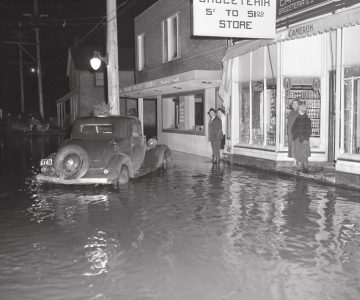
Hurricane Hazel’s Place in Headwaters’ History
Sep 18, 2018 | | Historic HillsWhen Hurricane Hazel finally blew itself out in October 1954, the damage and casualties left behind made it Ontario’s biggest weather event of the century. The flood control plans that followed were even bigger.
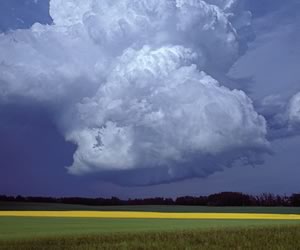
Big Weather
Jun 18, 2009 | | EnvironmentHold on to your hats! The weather, she-is-a-changing. Global warming is exacerbating Canada’s gloriously variable weather, adding a growing current of concern to our favourite topic of conversation. It’s been more than two decades since the “big tornado” hit these hills in 1985, but in recent years the incidence of smaller tornadoes, high winds and violent storms has escalated.
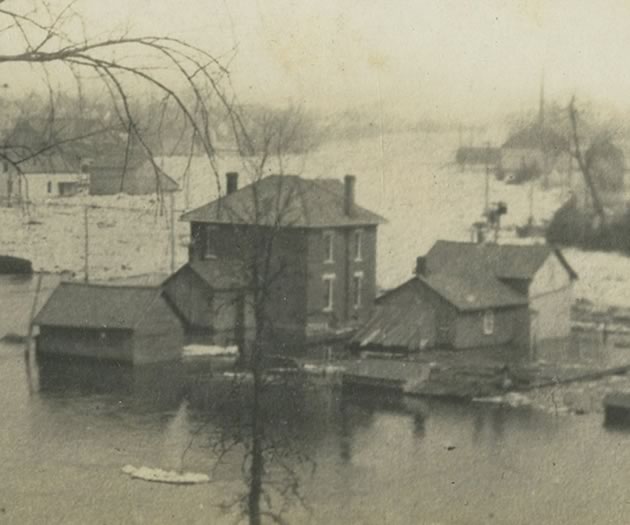
The Grand River – When Your Neighbour is a River
Jun 20, 2016 | | Historic HillsNot only does the Grand River lay out nature’s beauty, it also offers opportunities for recreation, commerce and development. Yet all this comes at a cost, for the Grand can be both friend and foe.

A Day in the Life of a Volunteer Firefighter
Jun 16, 2011 | | Back IssuesA simple “click” is sometimes all it takes. Somebody is having a bad day. That “click” is the emergency radio channel, XJI 799, coming on line.

Climate Change and the Young
Jun 20, 2019 | | Environment“We the young have started to move.” Youth here and around the world raise a battle cry for action on climate change.











